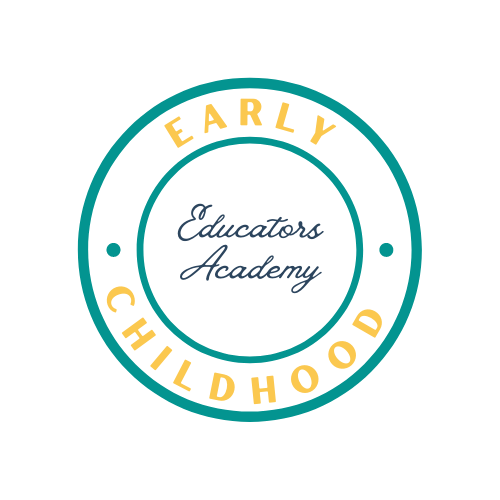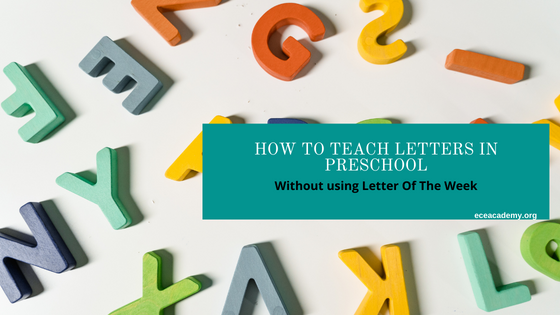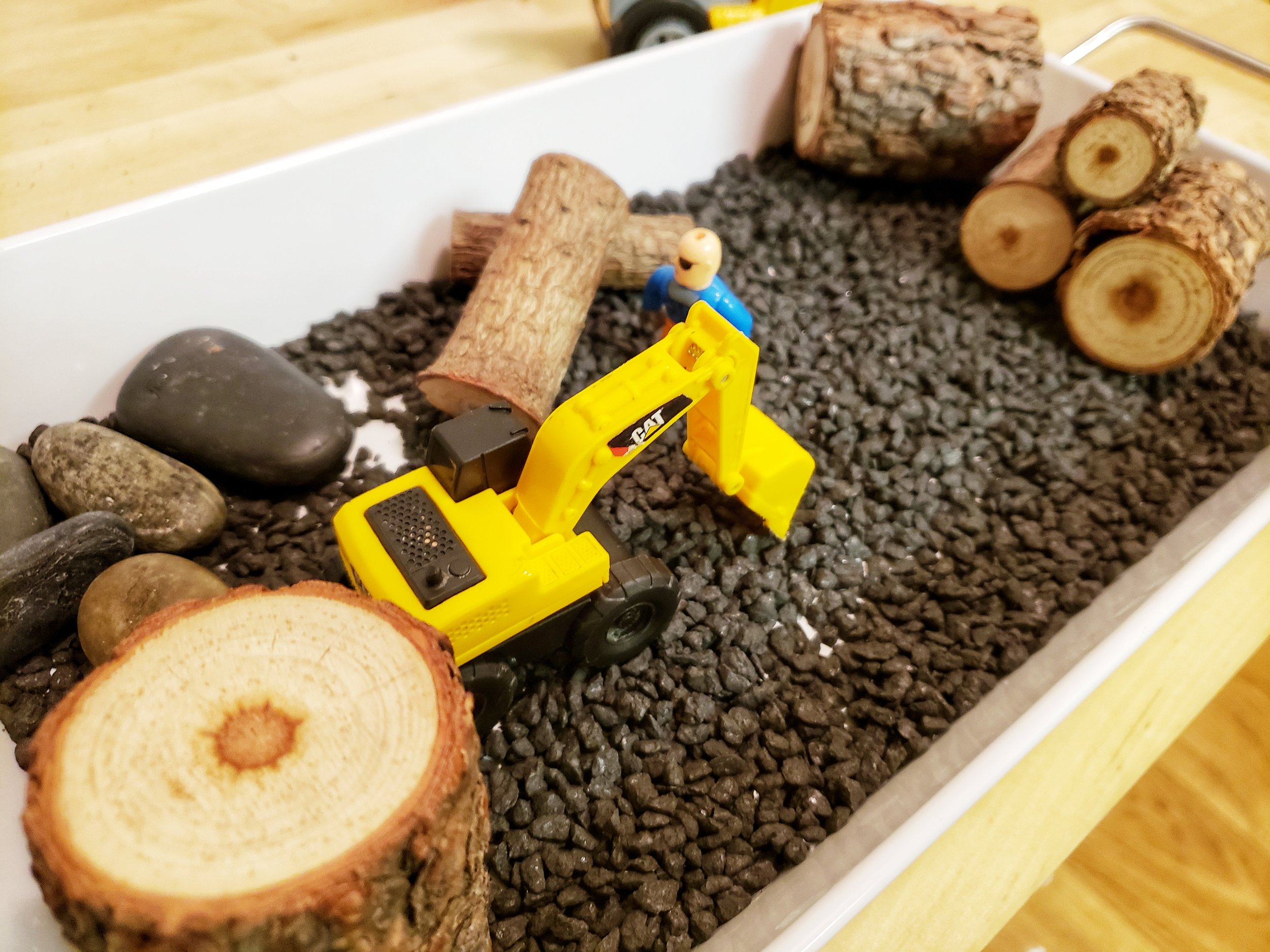How Do You Teach Letters Without Using Letter Of The Week?
Letter of the week has long been a popular way for preschool teachers to introduce letters and letter recognition to their little learners.
Typically, the letter of the week is structured by introducing one letter, and then for the next few days, the teacher reviews the letter at group time. Sometimes a craft or worksheet focusing on that same letter is also integrated.
Although it can be convenient, studies are consistently showing how this method is not the most effective way to introduce letters and literacy.
This doesn’t mean that teachers haven’t seen results from this practice, but it does mean that there are more developmentally appropriate and impactful ways to teach them.
Children are constantly learning so there’s no reason to isolate opportunities to learn letters throughout their day.
With the letter of the week method, children are expected to retain information for that week’s letter plus the previous letters with only a small time frame to master the new information they had been given.
There’s little time for the children to explore the other letters in-depth, no opportunity for real-world applications, and individualizing these lessons are rare, if done at all, because LOTW is usually introduced during large group or as a craft.
We miss the opportunity to tie literacy into their everyday experiences by limiting exposure and making children reliant on the teacher to feed them the information.
But how exactly do you help students learn their letters and letter recognition if you’re not using letter of the week?
It’s important to know that there are certain pre-literacy skills children need to learn first.
Simply being able to memorize a letter or repeat after you won’t be helpful for the child when they begin attempting to learn how to read, write and spell.
They need to understand things like the concept of print (ex: reading left to right for English readers or in whatever direction is correct for their native language), phonological awareness (hearing the difference in sounds), and narrative capabilities (ex: this happened first, then this happened next).
Activities like reading to them on a regular basis while pointing, emphasizing sounds while speaking, singing phonological rich songs, rhyming songs and poems, making animal noises while playing, etc can help build these skills.
Integrate these learning opportunities throughout their day and classroom. You can do this by:
Having meaningful books available and accessible (not just limited to the Library center)
Reading to them frequently, one-on-one and in a group
Labeling your classroom and the materials
Pointing out letters and sounds in conversation
Having conversations with children and avoiding “baby talk” (such as using words like diape-y instead of diaper)
In younger classrooms don’t feel pressured to have them know the full alphabet forward and backward. focus on strengthening those preliteracy skills.
Introducing Letters
When it comes to learning, young children learn best through hands-on and interactive opportunities and play.
To learn more about this you can check out our free training “What If We Stopped Having Circle Time”
Integrating letters into their everyday play and being able to physically touch and interact with materials helps them understand and retain the information.
This is the difference between rote learning vs active learning.
Rote learning they’re simply repeating A, B, and C out of habit or memorization. Which isn’t always a bad thing. Sometimes children pick up on letters through repetition.
For example, when they see their name next to their picture - they might not have decoded the individual letters yet, but they’ve come to memorize those lines paired with their face and now understand that must be their written name.
This is good! As mentioned before understanding print has meaning and significance, and it’s also different from drawings, is a preliteracy skill.
It becomes a problem when rote learning methods like flashcards and singling the alphabet every day is the only way children get information. And LOTW doesn’t delve any further than showing and memorizing in most curricula.
We want to make sure children aren’t just repeating the letters, but understanding their function so that they can move on to blending sounds, learning language rules, and spelling.
Hands-on activities and play help cement true understanding, and when we embed these opportunities into their whole day, as supposed to limiting it to a single moment like circle or crafts, then we can expand and present more opportunities to explore letters and a variety of them too - not just the dedicated letter for that week.
Ideas for fun and hands-on activities:
Tracing letters in shaving cream, sand, or rice trays
Creating Letter soup by mixing letter tiles in a bowl
Sculpting letters with playdoh or clay
Creating letters with natural materials (leaves, twigs, pebbles)
Letter-matching blocks, stickers, puzzles, etc
Letter scavenger hunts
Cutting letters and words out of magazines
Letter hopscotch or bean bag toss
Creating letter collages
Have these activities scattered throughout your different centers during free play.
Examples of this could be having the letter soup recipe in dramatic play, a letter-matching puzzle in manipulatives, and letter blocks in the block center.
Doing these activities spontaneously might not feel like “teaching” but children are natural learners and they’re absorbing information in those small moments.
Learning isn’t an isolated experience that only happens at circle time; it can happen during centers, snack, potty time, any time really!
Don’t hesitate to read the shelf labels out loud as you’re cleaning up, spell out things as you’re writing in front of children, point out when items have matching sounds (“Apple and Alison have the same sounds!”), and mention letters and words as you see them.
Start with their name.
Another preliteracy skill children need is the motivation to read, and introducing children to the letters in their name first can be a great way to get them excited about learning their letters.
Here are 5 ways to introduce their name:
Have parents label all of their belongings and teachers label their cubby. When it’s time to put away something or grab an item out of their cubby point out the label. Show the child the label on their lunch box also matches the one on their cubby. When it’s potty time you can ask something like “Can you grab me one of your pull-ups out of your cubby? It has your name on it. It starts with ‘A’”.
Have children “sign in” by circling their names in the morning or scribbling in a box next to their names. For really young kids you can also put their picture next to their name to help them identify it. As their skills develop remove the picture so they have to just identify their name.
Let them sign their own artwork. You can write their name, but encourage them to write it too.
Have cards with their name in different centers. You can put a small basket of cards with their names written on it in the manipulatives and children sort through it to find their own name, or laminate cards with their name and place it in the art center. See what the children feel inspired to create!
Use name cards. You can have children grab their name card and place it on the table where they want to sit for lunch, grab their card and sit down for morning affirmation, or use it to hold their spot if they’d like to ask for permission for something that is monitored. For example: if only three kids can fit at the sensory table at once, they can grab their name card and put it down to show they’d like to use it next when a spot is open.
You’ll be amazed at just how much children can pick up without an adult having to explicitly teach them.
Remember, learning for children is very organic and spontaneous so while you might not be doing flashcards or letter crafts, if you’re intentional about conversations, the materials in your classroom, and seeking out these opportunities while they play, you’ll see just how much learning they do!





















Aggressive behavior like hitting, kicking, and biting are easily cited as one of the most stressful behaviors in the early childhood classroom. Here are some tips for handling aggressive behavior in the PreK/daycare classroom.